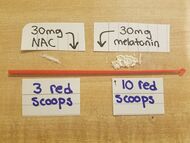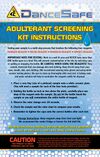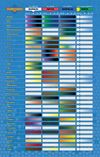Responsible drug use
Responsible drug use is a set of diverse ideas and practices based on the premise that recreational substances can be used in a healthy and responsible manner by consenting adult individuals. It is closely related to the concept of harm reduction, which seeks to minimize the risks and hazards of psychoactive substances while maximizing their benefits via education and training.
According to the harm reduction approach, recreational substance use is first-and-foremost to be understood as a high-risk activity that inherently involves the risk of addiction, serious bodily injury, and death. Therefore, the most pragmatic strategy an individual can adopt — other than complete abstinence, which may not always be realistic or desirable — is to carefully research each substance and take practical steps to reduce the risks and harms associated with using it, until the benefits outweigh the cost.
Recreational drug use may be viewed in a similar light as other risky-but-enriching activities, particularly extreme sports such as sailing, skiing, skydiving, surfing, and mountain climbing. More mundanely, it may also be compared to driving a car, riding a motorcycle, or flying in an airplane.
While these activities carry substantial risks (including death), it is nevertheless widely understood that these risks can be minimized to an acceptable level with proper education and training. Depending on the cultural context, the ability to participate in these activities may be viewed as an inalienable expression of one's freedom, self-determination, and dignity.
The philosophy underlying responsible drug use can be described as relatively radical in that it places absolute responsibility on the individual to conduct proper research and take the necessary safety precautions. This is accompanied by the understanding that there is no such thing as truly "safe" use, only safe(r) use, and that individuals are ultimately responsible for the outcomes of their choices, whether it is health-related, financial, or otherwise.
Advocates of responsible drug use point to the many well-known artists and intellectuals who have used drugs, experimentally or otherwise, with few detrimental effects on their lives. Critics argue that drugs are escapist, dangerous, unpredictable, and often addictive; therefore, responsible drug use is an illusion.
Examples of general harm reduction advice include:
- Educating oneself on the effects and legality of the substance being consumed
- Measuring accurate dosages and taking other precautions to reduce the risk of overdose
- Taking the time to chemically test all substances being consumed to determine purity and strength
- Do not swim.
- Not driving, operating heavy machinery, or otherwise being directly or indirectly responsible for the safety or care of another person while intoxicated
- Avoid recreational drunk dialing, emailing, etc, that may lead to socially negative consequences.
- Having a trip sitter when taking a substance with which one is not familiar
- Not attempting to trick or persuade anyone to use a substance they are not willing to use
- Not allowing substance use to overshadow other aspects of one's life or responsibilities
- Being morally conscious of the source of one's substances
- Avoid certain psychoactive substances
This page is dedicated to providing information about the various factors that should be considered when experimenting with or regularly using psychoactive substances. The first section covers general harm reduction practices for all substance classes while the latter is specific to hallucinogens.
General
Dosage 
-
Main article: Dosage In the context of recreational substance use, correct dosing is vitally important.
Choosing an inappropriately high dose of a substance is obviously problematic due to the risk of dangerous side effects. However, starting with too low of a dose can make the user feel uncomfortable and frustrated, which may lead to careless re-dosing and increase the risk of a cumulative overdose.
A helpful saying in the field: "you can always take more but you can never take less"!
-
Choosing dosage
Main article: Choosing dosage When choosing a dose, the user should avoid doses which they are uncomfortable or unfamiliar with. An inexperienced user should always start in the lower end of the dose range, with the goal of working their way up in small increments until they are familiar with the behavior of the substance.
Doses should always be adjusted upward with slight increases (e.g. 1/4 to 1/2 of the previous dose). Large, erratic increases (e.g. 2x or 3x the previous dose) should be strictly avoided. It is important to note that many substances do not have linear dose-response curves, meaning that doubling the dose amount will cause a greater than double increase (and rapidly result in overwhelming, unpleasant, and potentially dangerous experiences). Following this rule will significantly minimize the risk of a negative experience.
It is vital to remember that everybody reacts differently to every substance depending on factors such as their own personal tolerance, body weight, metabolism, and personal sensitivity. Another factor to consider is substance purity which is likely to differ between different vendors and batches of product.
For information on the appropriate dose for any substance, research should be done using a combination of sources like PsychonautWiki, Erowid, Tripsit, Wikipedia, DuckDuckGo, and Google.
-
Allergy testing
Main article: Allergy testing Some individuals, especially those with health issues, can exhibit adverse responses to substances in the form of allergic reactions, uncomfortable physical or cognitive effects, or hyper-sensitivity.[1] This risk can be mitigated by performing an "allergy test", which is simply dosing a minuscule amount of the substance (e.g. 1/10 to 1/4 of a regular dose) and waiting several hours to verify that one does not exhibit an unusual or idiosyncratic response.
-
Eyeballing
Main article: Eyeballing Do not eyeball. Eyeballing is a highly inaccurate and unreliable method of measuring substances which involves looking at a substance and making a rough guess of the amount. Since there is not much difference between 10 milligrams and 30 milligrams visually, it can easily result in taking too much of a substance, which can have fatal consequences.[2]
There are numerous forms of eyeballing methods including using micro scoops and the graph paper method, both of which result in inaccurate dosing.
Users should not trust a vendor's word that their product weighs a certain amount as it is not unheard of for vendors to accidentally or intentionally give out the wrong amount of a product, resulting in overdoses for some users.[3]
It is especially dangerous to eyeball substances that have extremely low doses (under 10 mg).
-
Milligram scales
Main article: Milligram scales 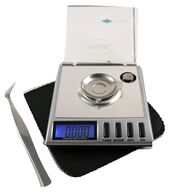 The GEMINI-20 portable milligram scale shown above is a popular scale recommended by Tripsit. These can be purchased at online retailers.
The GEMINI-20 portable milligram scale shown above is a popular scale recommended by Tripsit. These can be purchased at online retailers.When buying or using chemicals in powdered form, it is strongly recommended to invest in a reliable and accurate digital milligram scale to ensure the ingestion of safe and known doses.
To achieve the most accurate measurement, the scale should only be used on a completely flat surface away from vibrations, wind, and drafts. Low batteries can also affect the scale's accuracy, so one should periodically replace them. Scales usually come with a calibration weight which can be used to detect accuracy decreases.[4]
There is a large variety of different scales available online through various sites. To choose a quality scale, users should read the reviews before buying and come to their own personal decision. Users should ideally choose a scale that has a 0.001 gram (1 milligram) readability. When using a scale that has 0.005 gram readability (5 milligrams), the weight will be off by 5 milligrams in either direction, meaning that if one measures 20 milligrams of a substance, the results will be between 15 - 25 mg.
Milligram scales under $1000 cannot accurately weigh out doses below at least 50 milligrams and are highly inaccurate under 10 - 15 milligrams. For potent substances, the volumetric liquid dosing technique is advised.
Most milligram scales are more accurate in higher ranges (5 - 15 grams) than the lower ranges. Therefore, it is better to weigh chemicals while the included calibration weight is on the scale.
-
Volumetric liquid dosing
Main article: Volumetric liquid dosing Volumetric liquid dosing is the process of dissolving a compound in a liquid to make it easier to measure.
For harm reduction purposes, it is essential to prepare certain compounds which are too potent to measure with traditional weighing scales using a liquid solution. Most standard milligram scales cannot accurately weigh out doses below 10 - 15 mg.[5] This technique makes it possible to use a cheap $30 scale and still measure accurately to only a few milligrams.[6]
There is a volumetric dosing calculator located here which will calculate the amount of drug and solvent needed as well as the concentration.
Routes of administration
-
Main article: Routes of administration
- Oral cavity: Avoiding sublingual, buccal, and sublabial (under the lip) for substances that are bioavailable in the stomach is a good way to avoid mimics. For example, 25I-NBOMe breaks down in the stomach, but 25I-NBOMe has been sold as LSD, which has been attributed to several deaths[7][8][9][10] and may commonly be mistaken for LSD by sellers and users.[11]
- Respiratory tract (inhalation, vaporizing, smoking): It is harder to administer substances through the respiratory tract because the exhaled air often has significant amounts of residues due to improper technique. Improved bioavailability can be achieved with 1) holding the breath for as long as possible, usually a minute 2) If one notice exhaled mist (vaporizing) or smoke, then the desired dose can be divided into smaller doses which are repeated.
- Injection: Injection is the most dangerous route of administration and is highly advised against due to the elevated risk of overdose, addiction, and other health complications. Sharing injection materials can be fatal due to blood transmitted diseases and infections. If one is determined to inject, refer to the safer injection guide for information on reducing some of the risks associated with injection drug use.
- Insufflation ("snorting"): Frequently insufflating substances can damage one's mucous membranes. Sharing snorting equipment (straws, banknotes, bullets, etc) has been linked to the transmission of hepatitis C according to a study and researches warns that other blood-borne diseases can be transmitted as well.[12]
Recovery position 
-
Main article: Recovery position The recovery position refers to a position of the body in which an unconscious but breathing person can be placed as part of first aid treatment to prevent death by the suffocation of vomit after a drug overdose.
Many combinations of substances, especially depressants such as alcohol and GHB, can result in dangerous or even fatal levels of respiratory depression. There is an increased risk of vomiting during unconsciousness and death from the resulting suffocation.
If nausea or vomiting occurs, users should attempt to fall asleep in the recovery position or have a friend move them into it in order to prevent possible death.
Reagent testing kits 
-
Main article: Reagent testing kits When purchasing substances online or in-person, the user should always seek precise knowledge of which chemical they are in possession of because it may very well differ from what it was advertised or sold as. If this is the case, it could potentially result in a negative experience, serious injury, or death. Investing in reagent test kits (e.g. Marquis, Mecke, Mandelin, or Ehrlich) will provide the ability to test chemicals at home without needing to submit them to a laboratory.
Reagent results can also be compared with data found online to verify chemical content. Test kitting has become particularly important since Chinese chemical manufacturers became involved in the research chemical scene, sometimes selling impure and/or mislabeled products.
There are detailed instructions on how to use these testing kits available here and displayed within the infographics below.
Dangerous combinations 
-
Although many substances are reasonably safe by themselves, there are many combinations which can be extremely dangerous or even fatal. This should always be considered when combining multiple psychoactive substances and adequate independent research must be performed in order to determine the safety of the combination if one wishes to avoid injury, hospitalization, or death.
Many prescription medications interact negatively with commonly used recreational substances. The most common cause of substance-related deaths is the combination of depressants (such as opiates, benzodiazepines, or alcohol) with other depressants.
-
.
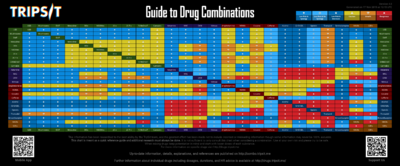 The image above is a useful chart which can be used as a quick reference tool for determining the safety of common combinations. For more information please visit its original creators at TripSit.me
The image above is a useful chart which can be used as a quick reference tool for determining the safety of common combinations. For more information please visit its original creators at TripSit.me
Effects 
-
Main article: Subjective effect index It is important to know in advance the duration, subjective effects and potential adverse effects which the substance or combination of substances are likely to produce. There are many online resources to use for education and reference regarding this aspect of substance usage, such as the psychoactive substance index.
For further research on the effects of any substance that one may be considering, a combination of Erowid, Tripsit, Wikipedia, and Google can be used. It may also help to read relevant anecdotal trip reports found here on PsychonautWiki or elsewhere on the internet. Additionally, discussion forums like bluelight often have useful information, particularly for novel psychoactive substances, although users should read the posts there critically.
If the user knows the exact effects of the substance in advance, then they will know what to expect. This is something that significantly reduces the chances of a negative experience by a huge margin through the prevention of unexpected circumstances.
Addiction 
-
As addiction is a serious and well-known risk of using substances, the user should carefully monitor the frequency and intensity of any substance use to ensure it is not sliding into abuse and addiction. In particular, many stimulants, opioids, and depressants are known to be highly addictive. Careful consideration and research should be put into the regular use of any of these substances (and any substance in general). There are certain smartphone apps that can help keep track of one's substance use.
Although the classical psychedelics are considered physically non-toxic and non-addictive, this is not the case with all hallucinogens. Dissociatives, deliriants, entactogens, and certain psychedelics (e.g. DOx, 25x-NBOMe, 2C-T-x) may come with potential adverse health effects that need to be individually researched before use.
Any hallucinogen can cause problems with a person's psychological health if overused. Keep in mind that substance use becomes an addiction once the negative consequences start to outweigh the positive aspects and interferes with the user's work and relationships, but they continues to use regardless.
Hallucinogens
The information below is exclusively tailored for the use and experimentation with hallucinogens such as psychedelics, dissociatives, and deliriants.
Setting 
- Choosing a suitable place to experience the effects of a hallucinogen is extremely important and plays a major role in determining the outcome of the experience. The ideal place for an inexperienced user is a familiar, safe, indoor environment over which they have full control and is devoid of factors that can negatively influence one's mental state. In order to prepare a proper setting for hallucinogens, it is advised to take the following steps:
-
- Ensure that one is completely free of responsibilities for the duration of the experience, and ideally the day after. This is because even the simplest of tasks can become incredibly difficult and potentially stressful to perform while under the influence of hallucinogens. The user should be prepared to fully relax and not perform chores or everyday routines. This includes driving and operating heavy machinery.
-
- Avoid people who are not directly participating in the experience. This includes relatives who may be sleeping in the same house and friends that are anything but extremely trustworthy, understanding, and informed about the effects of hallucinogens. The mere vicinity of unaware people can prompt anxiety and paranoia as well as prevent full immersion in the experience.
-
- Avoid unfamiliar, loud, cluttered, and/or public environments. The user should select an environment over which they have a considerable degree of control. This can be as simple as having the ability to adjust the air conditioning settings or freely enter and exit a restroom. One should be able to sit, lie down, and walk around as they please for the full duration of the experience. The chosen setting should ideally be equipped with privacy, relaxing music, comfortable seating, and readily available food and water. Examples of such settings include a safe, comfortable room at home or a friend's house.
-
- Avoid sources of anything that can generate "bad vibes." The user should not expose themselves to unpleasant or disturbing stimuli such as scary films or dark music. If bad vibes are encompassing the experience, they can be escaped by quickly changing the immediate environment the user is in. For example, if one is sitting down with the lights off, stand up and turn the lights on, change the music, or move to a different room in the house.
-
- Once the user has become intimately familiar with their substance of choice, it is up to them as an individual whether they would be comfortable tripping in a less controlled environment such as out in nature, social gatherings, parties, raves, etc. However, it should be noted that tripping in these settings entails considerably more physical and legal risk.
Set (State of mind) 
-
The user's set or state of mind in plays a major role in determining the outcome of a trip. Hallucinogens amplify one's current state of mind, mood and outlook: a positive mindset will likely become more positive and a negative one will become even more negative. As a result, hallucinogens should generally be avoided during acutely stressful or negative periods of life. Users should be fully aware of the ways in which hallucinogens, particularly psychedelics, are able to force one to face their internal problems that they may not be psychologically prepared to handle at that time.
Those with preexisting mental conditions (especially individuals with psychotic illnesses like schizophrenia) should avoid hallucinogens due to the way they can strongly amplify one's underlying mental and emotional state as well as promote delusions and hallucinations. Those who wish to take hallucinogens with such conditions should seek the advice of a qualified medical practitioner.
A common piece of advice while tripping is to "let go" and allow the effects of the substance to take charge. One should take the metaphorical passenger seat and forgo trying to control or suppress any part of the experience. It is extremely important that the user simply relaxes and take things as they come, as any resistance will only serve to amplify what is trying to be avoided.
Additionally, the user must understand that the experience of tripping is often ungraspable, meaning that one should accept being unable to understand or express the full scope of what is happening during the experience. The user should embrace the fact that their thought processes, although potentially more lucid in some ways, will be unavoidably impaired along with fine motor control, conversational skills, and situational awareness. The user should be sure to frequently remind themselves that these effects are normal and, most importantly, temporary.
Bodily state 
-
The user's current bodily condition is just as important as one's mood and mindset when going into a trip. If one feels tired, sick or injured, these sensations will manifest as amplified versions of the same conditions which, when combined with possible body load, may easily detract from or ruin the experience.
Instead of tripping while stressed, tired, sick or injured, one should wait for a more suitable opportunity. This will drastically lower the chances of having a negative or unfulfilling experience.
Trip sitters 
-
Main article: Trip sitter When using hallucinogens, a trip sitter is strongly recommended to be present, particularly if one is inexperienced with the substance. It is the trip sitter's responsibility to assist the individual or group by maintaining a calm and grounded frame of mind. This can be accomplished by simply watching over the trippers and calmly reassuring them if they experience any anxiety or stress, while also preventing them from coming to any harm. There is an obvious correlation between the name "trip sitter" and "baby sitter": this is because trip sitting often feels like babysitting and it is a responsibility that must be taken every bit as seriously.
A good trip sitter must fulfill a number of requirements. In addition to being a generally responsible adult, they should ideally be sober and able to relate to the group members' situation from either personal experiences or researched knowledge. Trip sitters should understand that when an individual is tripping, they may not be able to communicate or interact as they usually do. Also, their balance and spatial judgment may be impaired so assistance in performing tasks such as staying hydrated or navigating through an area can greatly reduce anxiety and confusion. The trip sitter can participate in the conversation, but should also remember to give the trippers space to explore the experience without too much external influence.
Once the user becomes familiar with a substance, it becomes a personal choice as to whether or not they feel comfortable enough to trip without a sitter. It is also advised to use trip sitters when taking high doses or a dose one has never taken before. It should be remembered that having friends around while tripping is the best way to avoid potential psychological, medical, or legal consequences.
Anchors 
-
 "You are tripping on 2C-P" - This sign is an example of an anchor which can be used to keep one grounded during ego death.
"You are tripping on 2C-P" - This sign is an example of an anchor which can be used to keep one grounded during ego death.In the context of hallucinogen use, an anchor is an activity or physical object which keeps the user grounded during the heavy distortion of a person's sense of time, space, memory, and sense of self. At higher dosages, this can result in extreme disorientation and confusion. Anchors are often used to counteract this and maintain one's concept of the current situation as it is within reality.
Examples of anchors include:
-
- Familiar and uplifting music. An example of this includes our community good vibes portal. However, users are encouraged to create their own playlist that is composed of music one personally associates with being happy and relaxed.
-
- An extremely personal and ingrained image or object.
-
- Continuous repetition of a meaningful word or motto as a mantra.
-
- Writing an easily readable reminder onto a large piece of paper and placing it close within one's visual field throughout the experience. Common reminders include the name of the substance along with its dosage and phrases such as "You are tripping on LSD." The same principle can be used to write reminders on one's hand or other visible body parts.
-
- An item of clothing or an accessory that is only worn during and therefore associated with the act of tripping.
Aborting trips 
-
Hallucinogens have the potential to become overwhelming and push the user into a paranoid or dreadful mood, particularly if they are inexperienced or in an inappropriate set and setting.
If one decides to terminate the trip, benzodiazepines and other sedatives such as some antipsychotics can be considered analogous to an "eject button" of a downhill-headed or extensively long trip. These substances tend to be very effective tools in preventing panic attacks, paranoia, and possible traumatic experiences.However, experienced users generally advise trying to wait out difficult parts of a trip if possible. Challenging moments are often temporary and can turn out to be catalysts for the greatest learning experiences.
See also
External links
- Responsible drug use (Wikipedia)
- The Importance of Measured Doses (Erowid)
- Psychoactive Vaults: Dose (Erowid)
- Research Chemical FAQ (Erowid)
- Guide to Drug Combinations (TripSit)
- Fundamentals of Responsible Psychoactive Use (Erowid)
References
- ↑ Erowid Psychoactive Vaults : Dose
- ↑ Ask Erowid : ID 2282 : How big is a milligram?
- ↑ Erowid Psychoactives Vault : Basics: The Importance of Measured Doses
- ↑ American Weigh Scales, Inc Gemini-20 User Manual | https://awscales.com/content/scales/amw-gemini20/gemini-20_manual.pdf
- ↑ 3-MeO-PCP - TripSit wiki
- ↑ Erowid Psychoactive Vaults : Liquid Measurement Technique
- ↑ 7.0 7.1 Erowid. "25I-NBOMe (2C-I-NBOMe) Fatalities / Deaths". Drug Website. Erowid. Retrieved February 28, 2016.
- ↑ 8.0 8.1 Hastings, Deborah (May 6, 2013). "New drug N-bomb hits the street, terrifying parents, troubling cops". New York Daily News. Retrieved May 7, 2013.
- ↑ 9.0 9.1 Feehan, Conor (January 21, 2016). "Powerful N-Bomb drug - responsible for spate of deaths internationally - responsible for hospitalisation of six in Cork". Irish Independent. Retrieved January 22, 2016.
- ↑ 10.0 10.1 Iversen, Les (May 29, 2013). "Temporary Class Drug Order Report on 5-6APB and NBOMe compounds" (PDF). Advisory Council on the Misuse of Drugs. Gov.Uk. Retrieved June 16, 2013.
- ↑ 11.0 11.1 Iversen, Les (May 29, 2013). "Temporary Class Drug Order Report on 5-6APB and NBOMe compounds" (PDF). Advisory Council on the Misuse of Drugs. Gov.Uk. p. 14. Retrieved June 16, 2013.
- ↑ Sharing Drug “Snorting Straws” Spreads Hepatitis C, 2016
